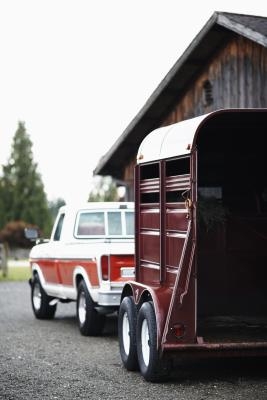
If you need to protect your cargo from the elements, you can build a plywood enclosure for your 5-by-8 foot utility trailer. Many utility trailers have metal stake mounts either welded or bolted to the sides of the frame, which will accommodate 1-by-4 boards. You can mount plywood walls to the trailer with 1-by-4 extension legs. Once the enclosure is fastened together and weatherproofed, your cargo will be protected and concealed from view.
Measure and note the separation distance between the front, rear and side stake mounts on the trailer frame. Measure between the inside edges of the mounts. The front and rear, and the side mount measurements, respectively, should match.
Measure the stake mount insertion depth. This depth should measure between 3 and 5 inches and will be used to determine the length of the plywood wall leg extensions.
Cut six 1-by-4 boards to a length that matches the stake mount separation distance on the sides of the trailer frame. Cut six 1-by-4 boards to a length that matches the stake mount separation distance on the front and rear of the trailer frame. These 12 boards will be horizontally mounted to the plywood walls.
Cut eight 1-by-4 boards to a length of 4 feet plus the stake mount insertion depth. Each board should measure between 51 and 53 inches, depending on the insertion depth. These boards will be mounted vertically to the plywood walls and used to attach each wall to the trailer frame.
Frame the two 48-by-96 inch plywood side walls. Orient the walls so that the 96-inch sides are horizontal. Lay three horizontal 1-by-4s, cut to the side stake mount separation distance, at the top, middle and bottom centers of each plywood board. There should be equal plywood space on either side of the 1-by-4s. Fasten the 1-by-4s with a screw gun with a pair of wood screws at the left, center and right ends of each board.
Lay a vertical 1-by-4 board along either side of the horizontal boards on each plywood side wall. Allow the excess board length to extend from the bottom of each plywood wall. Fasten the boards with the screw gun and a pair of wood screws at the top, middle and bottom of each board. The 1-by-4 frame should resemble a step ladder with legs extending past the bottom of each plywood wall.
Frame the two 48-by-58 1/2 inch front and rear walls following the same procedure that was used for the side walls. Orient the plywood walls so that the 58 1/2-inch sides are horizontal. Center the horizontal 1-by-4s at the top, middle and bottom of each plywood wall. Lay vertical boards along either side of the horizontal boards. Fasten the boards with wood screws and the screw gun.
Place the 58 1/2-by-96 inch plywood board flat on the trailer frame. Drill 3/8-inch screw holes through the board to accommodate the frame's mounting holes. Fasten the board to the frame with lag screws and a socket wrench.
Mount the front and side walls to the trailer frame by inserting the wall extension legs into the corresponding stake mounts.
Apply a line of glue along the side edges of the front wall. Sandwich the front wall between the two side walls. Drill 3/8-inch screw holes to accommodate two equally spaced steel angles along both front corners. Fasten the steel angles to the corners with lag screws and the screw gun.
Apply a line of glue along the top edges of the front and side walls. Place the 60-by-102 inch plywood ceiling board on top of the three-sided box. Allow the excess 102-inch length to extend from the rear of the trailer. Drill 3/8-inch screw holes to accommodate equally spaced steel angles mounted along the horizontal front and side corners of the box. Attach two steel angles along the front corner and three angles along each side corner. Fasten the steel angles with lag screws and the socket wrench.
Mount the rear wall to the rear trailer stake mounts. Drill 3/8-inch screw holes to accommodate two equally spaced rotating hasp hinges along each vertical rear corner. The hinge components should be attached to the rear edges of the side walls. The corresponding rotating cylinder components should be attached to the rear wall. Fasten the hinge and cylinder components with lag screws and the socket wrench. The hasps should latch over the cylinder, and the cylinder should rotate to lock the hasps in place. This will secure the rear wall during travel and allow quick removal for loading.
Weatherproof the enclosure by applying silicone sealant along the front and top corners and around the lag screws. The ceiling overhang should keep water from running into the rear of the trailer.